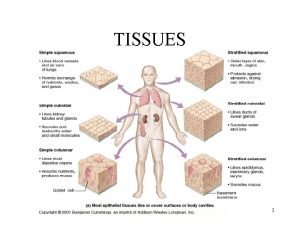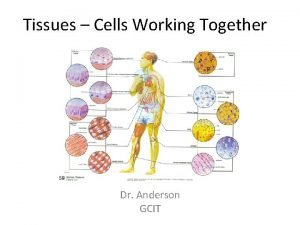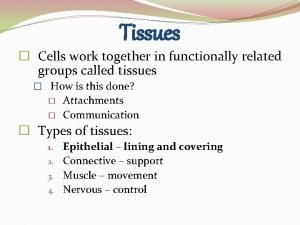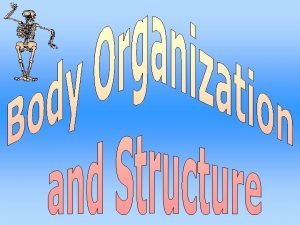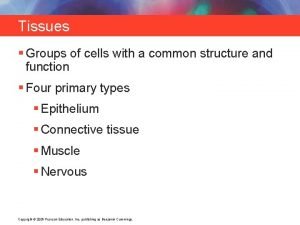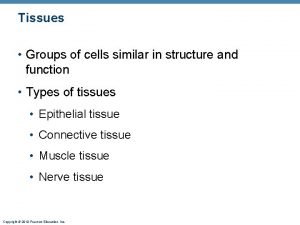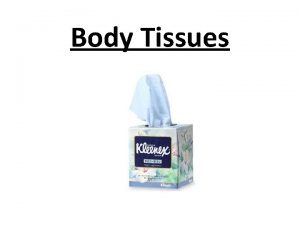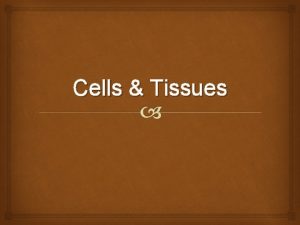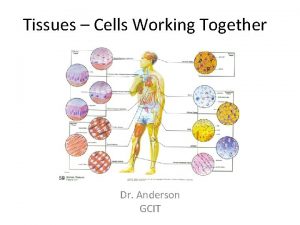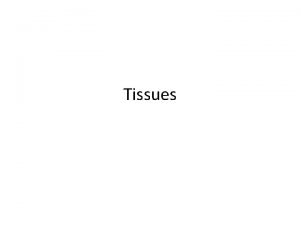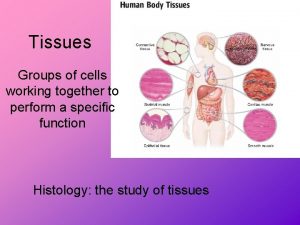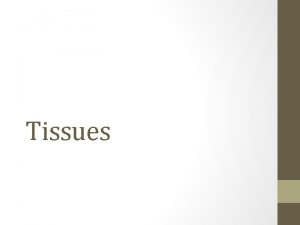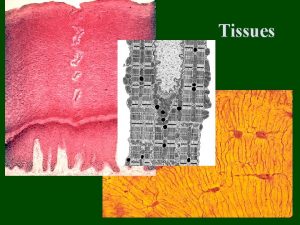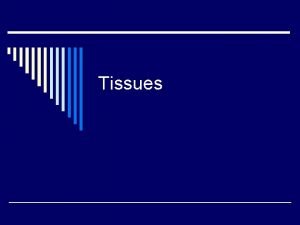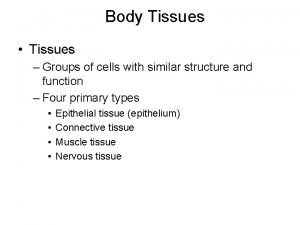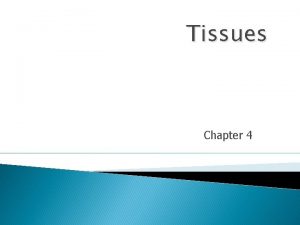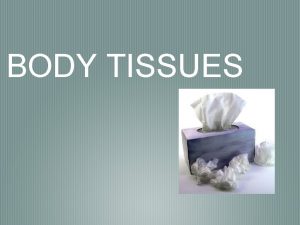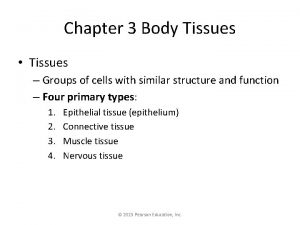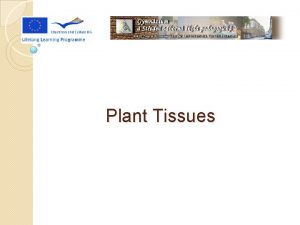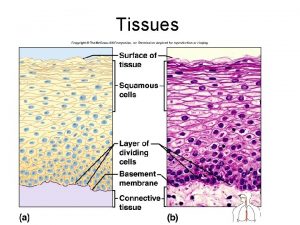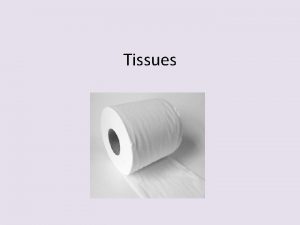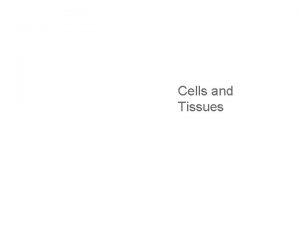TISSUES TISSUES Groups of cells working together in




























- Slides: 28

TISSUES

TISSUES • Groups of cells working together in similar function

4 MAJOR TISSUE TYPES Epithelial (protection) Connective (bind organs) Muscle Nerve (movement) (communication)

EPITHELIAL TISSUE • • Protective coverings Secretion Absorption Excretion • Lack blood vessels • Readily divide • Tightly packed

9 types of Epithelial SIMPLE SQUAMOUS STRATIFIED CUBOIDAL SIMPLE COLUMNAR GLANDULAR STRATIFIED SQUAMOUS PSEUDOSTRATIFIED COLUMNAR TRANSITION AL STRATIFIED COLUMNAR

SIMPLE SQUAMOUS EPITHELIUM • Single layer of thin flat cells • Allow substances to easily pass through • PROTECTION • Air sacs of lungs (alveoli) • Capillary walls • Blood & lymph vessels • Membranes that line body cavities

SIMPLE CUBOIDAL EPITHELIUM • Single layer of cube shaped cells • SECRETION • ABSORPTION • Ovaries • Kidney tubules • Gland ducts (salivary, thyroid, pancreas)

SIMPLE COLUMNAR EPITHELIUM • Single layer of elongated (column) shaped cells • Thick • SECRETE DIGESTIVE FLUIDS • ABSORB NUTRIENTS • Stomach • Intestines (microvilli) • Oviducts • Uterus

STRATIFIED SQUAMOUS EPITHELIUM • Many layers of flat cells • Thick • Deeper cell layers push older layers away (keratinization) • WATERPROOF LAYER • Epidermis • Linings of mouth, throat, vagina, anal canal

STRATIFIED CUBOIDAL EPITHELIUM • Layers of cube shaped cells • PROTECTION • Lining of blood vessels & intestines (lumen) • Ducts of mammary glands, sweat glands, salivary glands, pancreas • Lining of ovarian follicles & seminiferous tubules

STRATIFIED COLUMNAR EPITHELIUM • Layers of elongated cells • ABSORPTION • SECRETION • Urethra • Vas deferens • pharynx

PSEUDOSTRATIFIED COLUMNAR EPITHELIUM • Appear layered but really are a single layer (nucleus at diff locations) • Usually have cilia • MOVE DUST & MICROBES • Respiratory passages

TRANSITIONAL EPITHELIUM • Can change shape in response to increased tension • Allow for expansion & contraction of some organs so contents don’t diffuse back into organ • Inner lining of bladder • Ureter • Parts of urethra

GLANDULAR EPITHELIUM • Usually found within cuboidal or columnar epithelium • Produce or secrete substances into ducts (EXOCRINE) or body fluids (ENDOCRINE) • Mammary glands • Sebaceous glands • Salivary glands • Sweat glands • Pancreas

CONNECTIVE TISSUE • Bind structures • Support & protection of body organs • Frameworks • Fill spaces • Store fat • Produce blood cells • Protect against infection • Repair tissue damage

CONNECTIVE TISSUE • Cells are farther apart • Abundant intercellular material (matrix) tissue space • Good blood supply (most) • Some rigid (bone & cartilage) • Some flexible (adipose & dense connective)

LOOSE CONNECTIVE • Also called AREOLAR • Delicate thin membranes • Collagenous fibers (collagen)… long parallel bundles, slightly elastic but tensile strength • Elastic fibers (elastin)… thin, stretch easily • BIND SKIN TO UNDERLYING ORGANS • FILL SPACES B/W MUSCLES • SUPPLY EPITHELIUM W/BLOOD • Skin beneath epithelium

DENSE CONNECTIVE • Also called RETICULAR • Closely packed (very little if any matrix) • Collagen & elastin (strong) • Low blood supply; slow repair/healing • BINDS BODY PARTS TOGETHER • Ligaments & tendons

ADIPOSE • “fat” • CUSHION JOINTS & ORGANS • INSULATION • STORED ENERGY • Beneath skin; b/w muscles • Surrounds most organs

CARTILAGE • Rigid • Mostly collagenous fibers • PROVIDE SUPPORT • FRAMEWORK • ATTACHMENT • PROTECT UNDERLYING TISSUE • DEVELOPING BONES • Skeleton, nose, ears, joints

TYPES OFCARTILAGE HYALINE • • • Most common Fine collagenous fibers Ends of bone & joints Soft part of nose Respiratory passages ELASTIC • Dense network of elastic fibers • Framework of external ear • Parts of larynx FIBROCARTILAGE Very tough Collagenous fibers Shock absorber Intervertebral discs Cushions bone in knee & pelvis

BONE • Also called OSSEOUS osteocytes (bone cells) • Most rigid connective tissue (mineral salts: Ca. PO 4; Ca. CO 3) • Abundant collagenous fibers • Good blood supply; heals rapidly • Red Marrow: produce blood cells • PROTECT BODY STRUCTURES & ORGANS • ATTACHMENT FOR MUSCLES • Skeleton, rib cage, skull

BLOOD Fluid filled matrix Red blood cells White blood cells Platelets TRANSPORT MATERIALS THROUGH BODY • HELP MAINTAIN STABLE INTERNAL ENVIRONMENT • In blood vessels throughout body • • •

MUSCLE TISSUE • Contractile (elongates & shortens) • MOVES BODY PARTS SMOOTH MUSCLE SKELETAL MUSCLE CARDIAC MUSCLE

SKELETAL MUSCLE TISSUE • STRIATED: long, threadlike cells w/ alternating light & dark bands • VOLUNTARY • Move head, trunk, limbs • Allow us to make facial expressions, write, walk, talk, chew, swallow, breathe • Muscle attached to bones

SMOOTH MUSCLE TISSUE • NO STRIATIONS • INVOLUNTARY • Spindle-shape • Control body processes (digestion; excretion; respiration) • Internal organs

CARDIAC MUSCLE TISSUE • • • Found only in HEART STRIATED INVOLUNTARY Cells join end to end Intercalated disks: allow nerve impulses to travel rapidly

NERVE TISSUE • • Neurons: nerve cells Long branching cells SENSE CHANGES COMMUNICATE WITH EACH OTHER, MUSCLES, & GLANDS COORDINATE, REGULATE, INTEGRATE BODY FUNCTIONS Brain Spinal cord Peripheral nerves
 Tissues are groups of similar cells working together to
Tissues are groups of similar cells working together to Tissues are groups of similar cells working together to
Tissues are groups of similar cells working together to Tissues are groups of similar cells working together to:
Tissues are groups of similar cells working together to: Body tissues chapter 3 cells and tissues
Body tissues chapter 3 cells and tissues Anatomy chapter 3 cells and tissues
Anatomy chapter 3 cells and tissues 4 primary tissue types
4 primary tissue types Body tissues chapter 3 cells and tissues
Body tissues chapter 3 cells and tissues Cells form tissues. tissues form __________.
Cells form tissues. tissues form __________. Tissues working together
Tissues working together Group of cells working together
Group of cells working together Cells working together form
Cells working together form Anatomy of a generalized cell figure 3-1 answer key
Anatomy of a generalized cell figure 3-1 answer key Where are loins on a human
Where are loins on a human Chapter 3 cells and tissues figure 3-7
Chapter 3 cells and tissues figure 3-7 Cell membrane phospholipids
Cell membrane phospholipids Cells are the building blocks of all living things
Cells are the building blocks of all living things How are ethnic groups and religious groups related
How are ethnic groups and religious groups related Groups of cells with a common structure and function.
Groups of cells with a common structure and function. Group of cells that are similar in structure and function
Group of cells that are similar in structure and function Cigre working groups
Cigre working groups Cuál es la diferencia entre la célula animal y vegetal
Cuál es la diferencia entre la célula animal y vegetal The organelle trail
The organelle trail Parafollicular
Parafollicular Prokaryote vs eukaryote
Prokaryote vs eukaryote Which organisms are prokaryotes
Which organisms are prokaryotes Haploid vs diploid venn diagram
Haploid vs diploid venn diagram Plant and animal cells venn diagram
Plant and animal cells venn diagram Masses of cells form and steal nutrients from healthy cells
Masses of cells form and steal nutrients from healthy cells Paranasal sinus development
Paranasal sinus development

